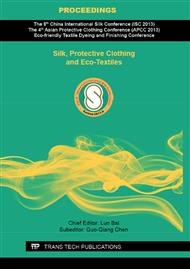p.15
p.21
p.25
p.36
p.39
p.43
p.48
p.57
p.62
The Transcription Express Characteristics of Several Genes in the Process of Bombyx mori Ovarian Carcinoma
Abstract:
Bombyx mori cell line (BmN) comes from Bombyx mori ovary cell subculture. In order to study the change of several genes transcription in the process of Bombyx mori ovary cells primary culture and subculture, we used Bombyx mori ovary organizations and BmN cell lines as research materials, used Real Time fluorescent quantitative RT-PCR to detect cyclin gene family (CyclinA, CyclinB, CyclinB3, CyclinE, CyclinL1), p53 and Telomerase genes transcription level in the ovary and BmN cell lines, and took Actin3 gene as reference to dispose the results. The results showed that in the Bombyx mori BmN cell lines the expression of CyclinA, CyclinB, CyclinB3, CyclinE, CyclinL1 and Telomerase genes were higher than those in the ovary. The expression of CyclinB in the BmN was more then 3.8 which was 76 times higher than that in the ovary; The expression of p53 gene in the BmN cell was lower than that in the ovary; The expression of Telomerase gene in the BmN cell was higher than that in the ovary. The results accumulated a reliable data for further study on the the role of cyclin gene family, p53 gene, and Telomerase gene in the process of Bombyx mori ovarian carcinoma.
Info:
Periodical:
Pages:
39-42
Citation:
Online since:
September 2013
Keywords:
Price:
Сopyright:
© 2013 Trans Tech Publications Ltd. All Rights Reserved
Share:
Citation:


